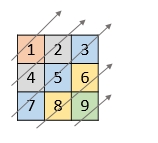1424. Diagonal Traverse II
Problem Statement
Given a 2D integer array nums, return all elements of nums in diagonal order as shown in the below images.
Example 1:

Input: nums = [[1,2,3],[4,5,6],[7,8,9]]
Output: [1,4,2,7,5,3,8,6,9]Example 2:

Input: nums = [[1,2,3,4,5],[6,7],[8],[9,10,11],[12,13,14,15,16]]
Output: [1,6,2,8,7,3,9,4,12,10,5,13,11,14,15,16]
Constraints:
1 <= nums.length <= 1051 <= nums[i].length <= 1051 <= sum(nums[i].length) <= 1051 <= nums[i][j] <= 105
Intuition
Links
Video Links
https://www.youtube.com/watch?v=5hG2nDEiwlE&ab_channel=AryanMittal
Approach 1:
Approach 2:
Approach 3:
Approach 4:
Similar Problems
Last updated